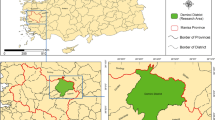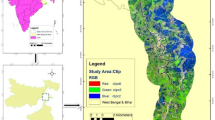Abstract
Bolhasan Forest region with an area of 5,725 ha is located on east north of Dezful County, Iran. The region belongs to natural forests of Dezful. Considering the area is mainly covered by valuable species of Amygdalus Scopartia, its sustainable exploitation and development as well as restoration enjoys great importance. Study ahead aims at selection of suitable habitats for under studied species using Analytical Hierarchy Process (AHP). Therewith, the required thematic maps were imported in to GIS Software and final suitability map was prepared. The results indicated that around 2,119 ha (37%) out of all study area has high suitability for habitat of Amygdalus Scopartia. In the meanwhile, 1,603 ha [equal to 28%] is categorized as good suitability class and 2,003 ha [35%] has poor suitability.




Similar content being viewed by others
References
Akhun Ali, A. R., Akhundi, M. R., & Akhun Ali, A. (2001). Project management foresty sources Bolhasan, Dezful (grade studies), Forests & Pastures & Watershed Organization. Natural sources Khuzestan province organization, p.15.
Ananda, J., & Herath, G. (2006). Reconciling Value Conflicts in Regional Forest Planning in Australia: A Decision Theoretic approach,poster paper prepared for presentation at theinter national association of agricultural economists conference, Gold coast, Australia, Agust 12–18, p.4.
Ananda, J. (2006). Implementing Participatory Decision Making in Forest Planning. Environmental Management, 39, 534–544.
Azari-dehkodi, F., & Nobukazu, N. (2003). Rehabilitation of shibateranthis pinnatifida matrix, aGIS approach, Hikobia, vol. 14, No. 1, pp. 9.
Chuanyan, Z., Zhongren, N., Guodonga, C., Junhua, Z., & Zhaodong, F. (2006). GIS- assisted modeling of the spatial distribution of Qinghai spruce (Picea Crassifolia) in the Qilian mountions, northwestern china based on biophysical parameters. Ecological Modelling, 191, 427–500.
Correa-berger, B. (2007). Developing a habitat sutability modelfor the spotted turtle using hybrid- deductive approach, A thesis report submitted in partial fulfillment of the requirements for the degrr of masters of seience in Environmet Science at the Rochester Institute of Technology Rochester, New York 14623.
Ekhay, O., González-Arenas, J., & Arriaza, M. (2008). Suitability assessment of olive plantations for Iberian Lynx habitat restoration, IFAPA (Juntade Andalusia).
Elfrengren, K., & Korpela, J. (2007). AHP- based expert analysis of forestindustry strategis. International Journal of Industrial andsystem Engineering, 2(4), 375–392.
GEF. (2005). Conservation of Biodiversity in the Central Zagros Landscape Conservation Zone Project Brief, project number PIMS2278.
Khaje Abdollahi, M. H. (2007). Cultivation Amygdalus Scopartia in sloping lands, Jhad agriculturist Khuzestan organization, extent circulation and order exploitation ministry of agriculture, No199.
Mashimo, Y., & Armitsu, K. (1981). Site classification for forest land use in Japan, 17th IUFRO world congress, Tokyo, Division I:103–116.
Marciano, C. (2003). Archiving a common strategy for an integrated rural development plan in south Italy using analytic hierarchy process, pisa, Italy, pp.12–15.
Mau-crimmins, T., Steiguer, J. E. d., & Dennis, D. (2003). AHP as a means for improving public participation:a pre-post experiment with university student. Forest policy and economics, 7(4), 501–514.
Qureshi, M. (2003). Application of the analytic hierarchy process to riparian revegetation policy option, small-scale forest economics. Management and Policy, 2(3), 441–458.
Saaty, T. L. (1980). The analytical hierarchy process: Planning priority setting resource allocation. New York: HillBook Co.
Saaty, T. L. (1988). Mathmatical methods of operations research. New York: Dover Publications.
Zobel, B., & Tabert, J. (1984). Applied Forest Three Improvement (p. 159). USA: John Willey and Sons Inc.
Author information
Authors and Affiliations
Corresponding author
About this article
Cite this article
Jozi, S.A., Majd, N.M., Saffarian, S. et al. Evaluation of Almond (Amygdalus Scopartia) Habitat Using Multi-criteria Decision Making Method. J Indian Soc Remote Sens 40, 607–617 (2012). https://doi.org/10.1007/s12524-011-0190-3
Received:
Accepted:
Published:
Issue Date:
DOI: https://doi.org/10.1007/s12524-011-0190-3




